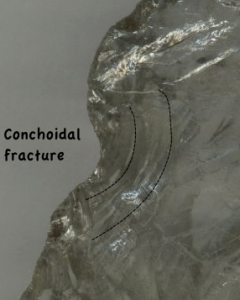
On the last morning of our immersion trip we had a choice between going to Hot Springs, Arkansas, with its geothermal springs and another museum, or hiking at Lake Catherine where we had spent the night. Since we’d been to two museums on the previous day, we pretty unanimously chose the hike. And it was great.

We took the Falls Branch Trail, which follows a couple of young, boulder-choked creeks that have are carving steep-sided valleys through nice clean limestone bedrock. The students were constantly bringing me rocks to identify, and they were almost invariable limestone, with a few pieces of quartz thrown in. The limestone was so clean that it was near translucent (fairly close to marble) and the cobbles in the stream bed were easy to mistake for smoky quartz, particularly if they were rounded enough that you could not look for quartz’s characteristic, curved, conchoidal fracture. Quartz also tends to be a lot harder than limestone, but the ultimate test, which the students really wanted to see, is to put acid on the rock. Limestone fizzes. I did not have any limestone on this trip (note to self: get some HCl for next time), but this little experiment is a nice follow up for our discussions of ionic bonding in chemistry. We have some limestone samples back at school so I plan on doing this as a follow-up.

Because Lake Catherine is very close to Hot Springs, it would not be surprising to find some quartz. The hot water that’s coming out of the springs flows up through cracks (faults) that extend deep beneath the surface. The deeper basement rocks are silicates, the granitic rocks that make up the continental crust, so the hot water dissolves some of that silicate material, and when the water cools down, ever so slightly, as it approaches the surface, some of those silicates will precipitate out to coat the walls of the faults with quartz. Sometimes they even fill up the faults entirely, leaving quartz veins.
The stream bed, being of young geological age, was a series of small waterfalls culminating in the five meter high drop that gives the trail its name. The water was clear and cold but with that beautiful aquamarine tint of dissolved limestone. There’s a whole lot more I could say about plunge pools and migrating nickpoints, but I’d probably go on too long. Besides we did not take the time to talk about those since there was so much else to see.

When we reached estuary of Falls Creek and Lake Catherine, the lake’s water was so calm that the kids started trying to skip stones. This of course provided a beautiful opportunity to look at water waves and interference patterns. As the ripples from each skip of the stone expanded, they melded. The constructive interference was easier to see in the field because it made for bigger ripples. But the photos show the destructive interference very nicely.
This was an excellent hike. We were a little pressed for time since we needed to get back to school before the end of the school day, but next time, I think, I’ll have us pack our food in and have lunch on the trail overlooking the waterfall and the lake. The ability to use these types of outdoor experience to integrate the academic work is one of the main reasons I enjoy the Montessori approach to middle school. All through the trip back though I kept thinking about how I could organize things so that we would never need to see the inside of the classroom again.



